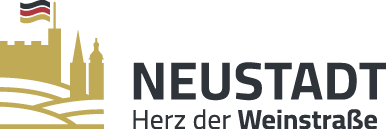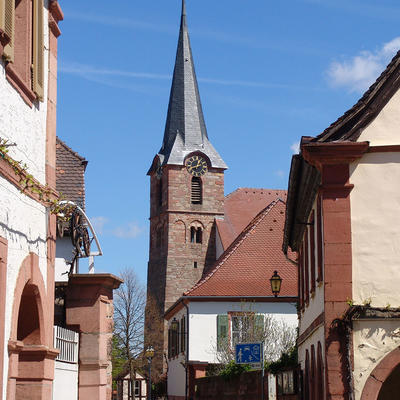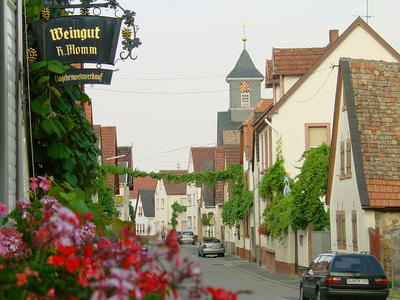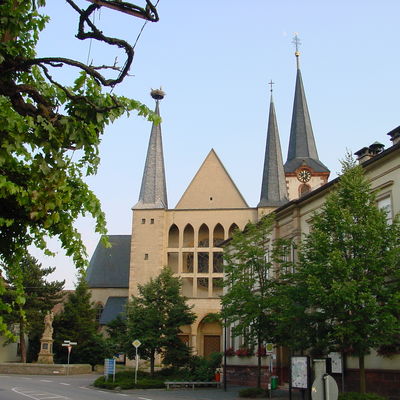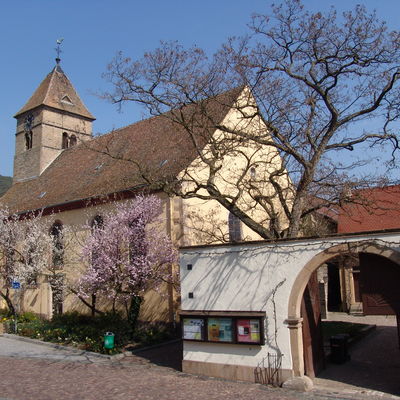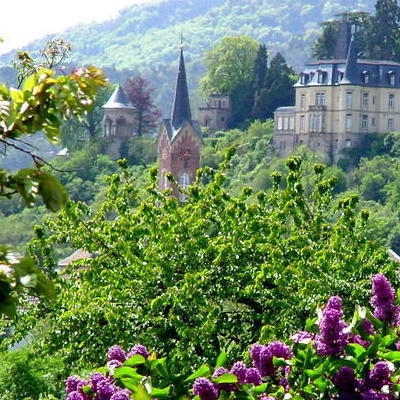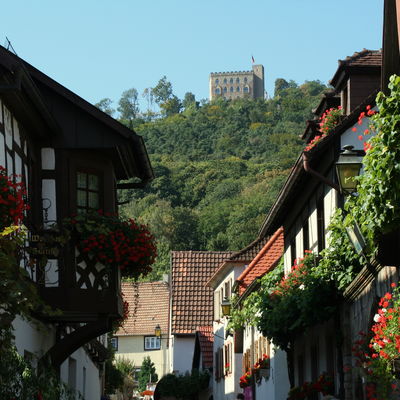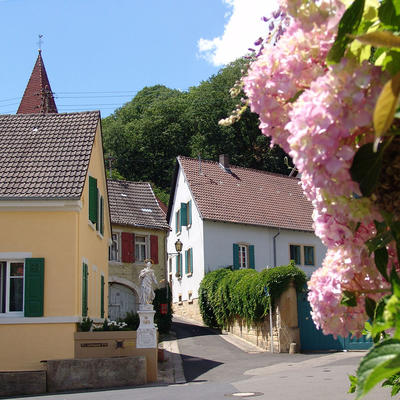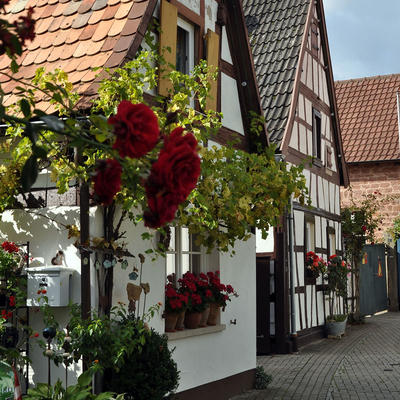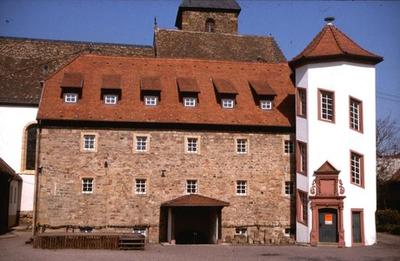Nine Wine villages
The rural character of the nine villages has been well preserved over the years. Houses built out of the regional sandstone are surrounded by endless wine fields and charming views into the Rhine Valley.
Smell the fragrance of the almond tree blossoms at the start of spring and stroll through the alleys along the gardens with Mediterranean plants such as figs, almonds and olives.
Diedesfeld
The most southerly-situated wine village, Diedesfeld, lies at the geographic centre of the German Wine Street, marked with a symbolic sandstone.
For over 2000 years viticulture has shaped the architecture of this typically Palatinate village with its renovated half-timbered buildings and warm sandstone walls. The baroque church of St. Remigius with a rococo pulpit was built in the 18th Century and looks over the Remigius fountain, decorated with glazed natural stone. Two hundred years older than the church is the old town hall, built in 1601, together with the largest trough to be found in the Pfalz, carved out of one piece of stone.
Watching over the village is Hambach Castle offering views as far as the Odenwald and the Black Forest. At its foot are the seemingly never-ending vineyards and fields which eventually lead to the River Rhine. Passing through the Klausental valley, a circular path leads past the castle and up to the Kalmit (673m). For the junior discoverer there is a natural playground in the Kirchwiesenstrasse.
Interested in learning more about Diedesfeld? Between the months of May and October, on every second Wednesday there is the “Guck- und Schlucktour” – a look and swallow tour – with a more culinary tour of the sights (reservation under tel.: +49 (0)6321 86146).
Duttweiler
The sleepy hamlet of Duttweiler is the smallest of Neustadt’s wine village and lies surrounded by vineyards and farmland, typical for the region.
19 wine farmers maintain the 1000 year old tradition of winemaking in the traditional vineyards of Mandelberg, Kreuzberg and Kalkberg, where the vines find the fertile soils so necessary to produce wines of international repute. The main wine festival is celebrated on the second weekend of August and is one of the oldest in the Palatinate. Quaint wine-farmers houses, lovingly-restored, welcome visitors to the festival which culminates in the coronation of the Duttweiler Wine Princess on the opening Friday. Duttweiler is also the ideal starting point for cyclists.
The “Cabbage and Turnips” trail is an easy cycle tour for the entire family and runs parallel to the German Wine Street. Duttweiler has numerous connections to the Palatinate Cycle Network so that one can easily go from “Wine to the Rhine” at the cathedral town of Speyer or take a refreshing swim in the idyllically situated, open-air swimming pool. The artist, Bernhard Matthäss, has discovered the Palatinate sandstone as the ideal raw material for his sculpture, to be seen in the Kreuzbergstrasse 41 (Reservations under tel.: +49 (0)6327 5846).
An intriguing feature of the village is the communication system. Although the latest village news is, of course, always to be heard at the baker’s shop, the loudspeakers situated throughout the village ensure that the latest news about village activities, the results of football matches, missing cats and, of course, who is leading the annual village cycle race is made known to all.
Geinsheim
It has to be wine that flows through the veins of the “Goisemer” since this outlying village has the largest vineyard area of all of Neustadt’s nine villages.
Half-timbered houses, many of them listed and the stork’s nest, more often than not inhabited, together with the church spire of St. Peter and Paul are the most popular sights of this traditionally agricultural village.
The Geinsheimer Ludwigskerwe – the main village festival – takes place on the last weekend in August. The middle of June is the time for the “Asparagus & Wine “ festival when guests *from near and far savour the locally grown asparagus. Whether served as asparagus tips or stems, as a delicious soup or served with salmon or ham... a veritable culinary feast. Not to forget, of course, “Pfälzer Grumbeere”, new potatoes and a fresh Silvaner or Rivaner, the ideal wine to accompany asparagus.
For those more actively inclined, the cycle tour (R-58) through the Ordenswald forest to Speyer is considered to be one of the best in the entire region whilst golfers can discover their handicap on the magnificent 18-hole golf course nearby. For further details please contact: Golf-Club Pfalz e.V. (Tel.: +49 (0)6327 97420).
Gimmeldingen
Sandstone walls, narrow streets and vine-covered entrances to wine-grower’s cellars characterise the village of Gimmeldingen. Although nowadays officially recognised as being a health spa, it was the Romans who first recognised the beneficial advantages of the sloping vineyards for viticulture.
A visible sign of such times is the Mithras plaque, created in honour of the God of Light – the original plaque can be seen in the Historical Museum of the Pfalz, in Speyer.
Gimmeldingen is the ideal starting point for hikers. Well-signposted paths lead into the Pfälzerwald Nature Park, the valley of Benjetal, to the scenic viewpoint Looganlage or into Silbertal - the Silver Valley. There is even a Nordic Walking trail leading through the valley. Information about viticulture and viniculture is available alongside the Wine Hike leading off the Fürstenweg. The wine village of Gimmeldingen is famous not only for its “Gimmeldinger Meerspinne” but also for the early almond blossoms which can be seen as early as March. The mild climate transforms the air into a perfume of almonds, and has been the ideal excuse for an “Almond Blossom Festival” and the coronation of the “Mandelblütenkönigin” for the past 60 years. The view from the König-Ludwig-Pavillon over the delicate pink sea of blossoms has long been a major attraction in Gimmeldingen. There is even a sandstone engraved with the words – “The Garden of Germany – the flowering Pfalz ! King Ludwig I 1856”, bearing witness to royal recognition.
At Whitsun, the villagers of Gimmeldingen celebrate the “Loblocher Weinzehnt” – the historical wine tithe, the third weekend in August is time for the “Gimmeldinger Weinkerwe” and the same weekend in October the “Gimmeldinger Herbst”. Reason enough to visit Gimmeldingen throughout the year.
Haardt
It was wine which allowed the village of Haardt to prosper: half-timbered houses dating back to the 18th Century, baroque villas with ornate stonework and coats of arms together with almost manorial wine estates are mute witness to this historical affluence.
The village itself, dating back over 750 years, is overlooked by the Count Palatinate Castle “Haardter Schlössel” and its terraced vineyards. An officially recognised health spa, it is also named the “Balcony of the Pfalz”, since, in clear weather, it is possible to look over the vineyards and see the distant Cathedral of Speyer.
Leading away from the village, there is a gentle walk to a park planted with exotic Mediterranean plants – Dr. Welsch Terrasse, from where the “Sonnenweg” takes one up to the ruins of the Wolf’s Castle – “Wolfsburg”. The wine trail leading off “Herrenlettenweg” brings you up to date on vinous matters with information about the cultivation of vines, the grape harvest and the character of the more than 16 different grape varieties grown in the village, such as the Portugieser, the Scheurebe or the Gänsfüßer. Eye-catching nooks and crannies offer a welcoming pause with views of ornate baroque villas. Thanks to its sheltered geographical site and mild climate, Mediterranean plants feel at home in the village of Haardt.
Hambach
Surrounded by vineyards and chestnut tree forests, the village of Hambach is divided into three geographical parts – Ober-, Mittel- and Unterhambach. Dating back to the year 865, this officially recognised health spa was originally known as Haganbach.
In Oberhambach one can visit the Church of Jakobus, one of the most outstanding baroque churches in the Pfalz, with its 12th Century fortified tower.
The town hall square in Mittelhambach is dominated by the one-time paupers’ hospices where the Jakobus pilgrims where once given shelter – the “Gasthaus Zum Engel” and the old town hall, built in baroque style 1739 – 1741. From here the road leads up the medieval “Schlossgasse” to the little castle of “Geispitz” with its mighty curtain walls.
The “Obergasse” takes us due south to Unterhambach with its hunting lodge built by the Prince Bishop of the year 1605, in the “Andergasse”. The history of Hambach is closely linked with Hambach Castle, once known as the “Kästeburg” (Chestnut Castle), later also the “Maxburg” being historically accepted as the birthplace of German democracy. As a casual mixture of new villas, historical winegrowers’ estates and a multitude of watering places and wells is how Hambach presents itself to today’s visitors Together with a heated outdoor swimming pool in a magnificent site, Hambach can also offer well-signposted hiking and cycle trails through both forest and vineyards, for example the Kirchbergweg or Obergassenweg with a breathtaking view of the plains below.
Königsbach
To the north of Neustadt, where the vineyards „kiss“ the forests, lies the wine village and health spa of Königsbach.
The old village centre, with the country estate built by the suffragan bishop in 1759 (now the wine-estate Engel) and the parish church of St. Johannes captivates its visitors with the olde world charm of its narrow streets and alleyways. The gothic spire of the church contrasts with its baroque nave. Inside there is a winged altar together with one of the last remaining altarpieces in the Pfalz, depicting the crucifixion and death of Jesus Christ against a golden background. Here is also the beginning of the Pilgrim’s Path with its 12 stations leading through the “Klausental” to the Chapel of the Holy Fourteen Helpers where, once a year, a festival is held in commemoration of Saint Margaret.
Memories of earlier lords of the manor are rekindled by the name “Hirschhornring”, to be read in the middle of the village. The vicarage of today was once the country residence of the Knights of Hirschhorn (from the Neckar valley).
But it is not only the breathtaking views offered by the village which makes it one of the most attractive places to live in Neustadt, it is also the elegant wines which are produced here in vineyards such as “Idig”, “Ölberg”, “Jesuitengarten” and “Reiterpfad”. Sample just some of these wines in Weingut Sommer or in Weinland Königsbach.
Lachen-Speyerdorf
As the name suggests, the two villages of Lachen and Speyerdorf have not always been unified. Today, however, these two villages, lying to the south-east of Neustadt, represent the largest of the nine wine villages.
“Lache” is an old-fashioned term meaning a small body of water whilst “Spiridorf” refers to the nearby river of Speyer, nowadays “Speyerbach”. The rural charm of the village with its intricate half-timbered houses constructed both in Franconian as well as Alemannian style dates back to the first settlers, the Celts, the Germanic tribes and the Romans in the year AD 774.
Mighty sculptures are to be found in the garden belonging to Prof. Gernot Rumpf in the Pestalozzistrasse. This famous sculptor created not only the “Elwedritsche” fountain but also the unique sundial on the evangelical church. Sunshine is the buzzword in Lachen-Speyerdorf; in the “Solarpark Flugplatz Lilienthal” the largest solar collection plant in Germany is under construction whilst for railway freaks, Dieter Hofherr has a collection of steam engines, railway carriages and track signals surrounding his house
Mußbach
The first mention of the wine village of Mussbach dates back over 1,300 years. In the middle of the village lies the “Herrenhof”, the oldest wine estate in the Pfalz, once belonging to the Order of St. John (tours on application).
Nowadays used as a Culture Centre for the entire region it offers a multitude of exhibitions and events . The most famous vineyard site is the “Mussbacher Eselshaut”.
As far as wine festivals are concerned, Mussbach need fear no competition from its neighbours. Starting in March the wine-growers show off their finest wines during the “Mussbacher Spitzen”. The first and second weeks in July are the setting for the “Eselshautfest” in the historical Herrenhof whilst the first weekend in August is the date for the “Mussbacher Weinkerwe”. From September to the beginning of November one can then sample the new vintage straight from the grape presses in the Winzergenossenschaft Weinbiet as well as many other wine growers estates.
The Church of St. John, built in gothic style, was once used by Catholics and Protestants alike, as a so-called “simultaneous” church.
The DLR is the centre of education and research into matters concerning both viniculture and viticulture and has a Mediterranean garden, well-worth seeing. The outdoor swimming pool provides the necessary refreshment during the summer whilst Christmas is the time for the Christmas market and warming, spicy mulled wines in the Herrenhof.
